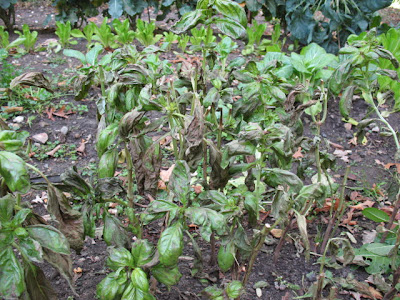 |
Soaker hose
|
Last month was the third driest August on record in Illinois and so far September has not been much better. Once more trees and established shrubs that we can usually take for granted are in trouble. It is time once again to get out there and give our larger plants a good soaking.
Spraying with a garden hose until the ground puddles up won't cut it. Leaving a sprinkler on all day will come closer, but most of your water will go where it is not needed.
For individual trees and large shrubs you are better off taking the nozzle off your hose and let your water trickle out near your plant roots at a pace the ground can absorb. "Slowly, but deeply," is the rule.
The best way to water trees, shrubs, and perennial beds, however, is to use soaker hoses. These hoses are wonderful. They allow you to water exactly where you need it without watering half the rest of the planet as well -- to say nothing of half the atmosphere like sprinklers do. This is merciful on your water bill.
 |
One of my soakers peeks out from under ground cover.
|
Soakers can become invisible easily. You can cover them with mulch or allow ground cover to creep over them.
And best of all for lazy gardeners like me, you can simply turn on the faucet and walk away for a few hours. If you wake up one morning and realize that you forgot to shut the water off, you will not find a lake outside.
The key to lazy-gardener watering lies in the layout of your hoses. You should buy a bunch of landscape pins -- the kind used to hold down landscape cloth that look like large staples. The pins will help you lay the hoses exactly where you want them.
You also want to look for hoses of different lengths. The standard is 50 feet, but if you look hard enough you can find 25 footers or even smaller lengths. With a choice of lengths, you can combine your hoses in a rational way so that they cover the plants you want without having lengths of extra hose to cope with. Similarly, you should buy different lengths of ordinary hose to get you from the faucet to where you want to start watering.
Don't try to run more than 100 feet of soakers in series. Since the water leaks out along the entire length of the hose, the water pressure decreases toward the end and the plants there receive less water.
 |
4-way splitter
|
The key to setting up your hoses to make up watering zones is the use of splitters. They allow you to equalize your water pressure and volume right at the faucet and give you almost infinite flexibility to run soakers anywhere you want.
At the end of the season I simply disconnect my hoses from the faucet and cover the brass ends with a baggies to keep dirt and debris out. The following spring I can be ready to water in about 10 minutes.































.jpg)